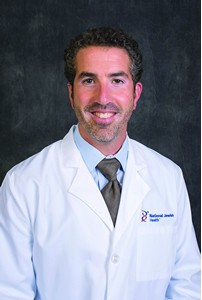A Monday afternoon session will answer whether it’s safer and more effective to use mycophenolate to treat interstitial lung disease in patients with scleroderma when compared with cyclophosphamide.
Answers to these and other questions about ILD in the setting of systemic sclerosis will be answered during the clinical symposium Evidence-Based Assessment and Treatment Options for Interstitial Lung Disease in Patients with Systemic Sclerosis.

“Our hypothesis was that mycophenolate given for two years is superior to a one-year treatment with cyclophosphamide in terms of efficacy and will be better tolerated,” said principal investigator Donald Tashkin, MD, Emeritus Professor of Medicine at the David Geffen School of Medicine, University of California Los Angeles. “There have been a number of uncontrolled studies and retrospective analyses suggesting that mycophenolate is beneficial in scleroderma interstitial lung disease, but the Scleroderma Lung Study (SLS) II is the first randomized, controlled trial to address this issue.”
The results of SLS II will be part of Monday’s symposium. Other presenters will discuss advances in diagnosis and assessment of ILD in patients with systemic sclerosis and the latest recommendations on hematopoietic stem cell transplantation.

“Rheumatologists rightly believe that scleroderma with systemic sclerosis is the most dreaded of the 100-plus conditions we call autoimmune disease,” said Keith Sullivan, MD, James B. Wyngaarden Professor of Medicine at Duke University Medical Center. “It is easily the most lethal disease to treat.”
About 40 percent of scleroderma patients develop significant decrements in lung function during the first five or six years of their disease, Dr. Tashkin said. Ten to 15 percent of patients lose half their lung function, and ILD is the leading cause of death in scleroderma.
Delays in diagnosis and evaluation have been an important barrier to timely and effective treatment for ILD. High-resolution CT (HRCT) scans have changed the outlook.
“Technology has dramatically improved our recognition of ILD with noninvasive tools,” said Aryeh Fischer, MD, Associate Professor of Medicine at the University of Colorado School of Medicine. “The standard of care in nearly all patients with systemic sclerosis has become a baseline high-resolution CT. We are diagnosing patients earlier, having a better sense of their disease, and a much better sense of their prognosis. The extent of their disease on HRCT is a primary driver of their prognosis, treatment, and long-term survival.”

Successive HRCT gives the rheumatologist an accurate picture of progression, Dr. Fischer said. Combining high-resolution imaging with pulmonary function testing can provide valuable evidence to help guide treatment decisions.
“It is gratifying to see ILD gaining more recognition in rheumatology,” Dr. Fischer said. “We see patients with systemic sclerosis every day. Even though we are not lung docs, it is difficult not to become involved in their lung care. It is all about how we can help our patients.”
New treatments are offering the prospect of better quality of life for patients with ILD. Two of the most promising drugs are pirfenidone and nintedanib, antifibrotic agents approved for use in patients with idiopathic pulmonary fibrosis. The initial study populations did not include patients with systemic sclerosis, Dr. Tashkin said, but trials in scleroderma ILD are planned.
Emerging data also support autologous hematopoietic stem cell transplantation in select patients.
“Stem cell transplantation has some acknowledged risks, including potential mortality,” Dr. Sullivan said. “But if a patient has failed DMARDs and has progressive lung deterioration, stem cell transplant can help in the right subset of patients. Sometimes, patients go through lung transplantation, a desperate treatment for a desperate disease. Autologous stem cell transplantation is much less complicated and does not require continuing immunosuppression. We will explore the patients for whom it is most appropriate and the evolving factors in the decision to use stem cell transplantation.”


